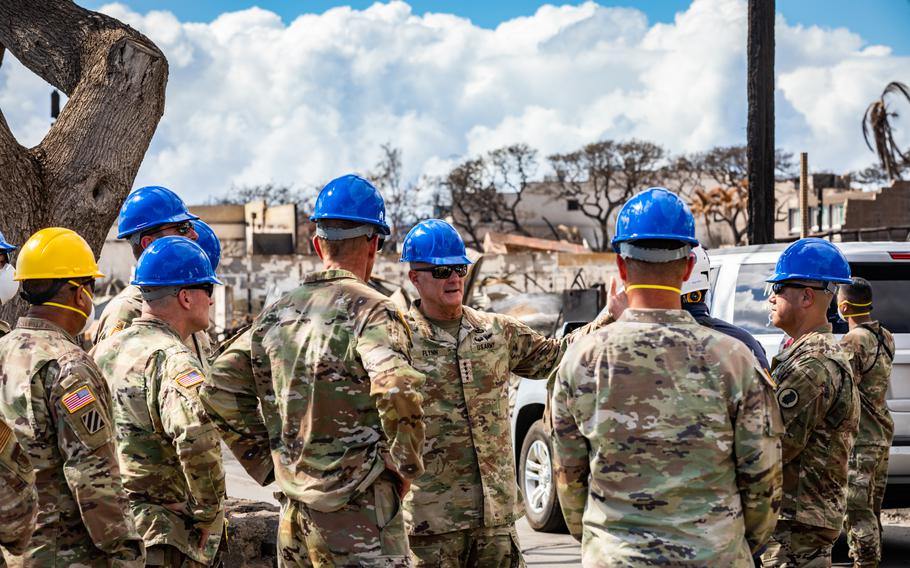
Army Gen. Charles Flynn, commanding general of the U.S. Army Pacific, alongside the command element of the Combined Joint Task Force 50, meets Tuesday, Aug. 15, 2023, with search, rescue and recovery personnel in Lahaina, Maui. (Matthew A. Foster/U.S. Army)
WASHINGTON – Nearly 700 Defense Department personnel are now in Maui assisting in recovery efforts in the aftermath of the wildfires that ripped across the island, the Pentagon announced Friday.
“Make no mistake, this joint task force is not in the lead. We’re not in the command,” said Army Brig. Gen. Stephen Logan, who is leading the military’s fire response known as Combined Joint Task Force 50. “We’re in the support of the county of Maui.”
State officials reported 106 deaths on Wednesday since the fires that took place on Aug. 8. According to Maui County, 2,170 acres burned in the vicinity of Lahaina and 678 acres burned in the vicinity of Kula.
Two CH-47 Chinook helicopters from the Hawaii National Guard equipped with large water containers known as Bambi buckets are being used to conduct fire suppression support, the Pentagon said. The Army Corps of Engineers has moved 32 generators from the Federal Emergency Management Agency to Maui, and 61 generators are staged at Oahu.
The Army’s Schofield Barracks in Oahu is also being used as a staging area to house and provide other facilities for emergency responders.
.jpg/alternates/LANDSCAPE_910/7975716%201.jpg)
Hawaii Air National Guard Staff Sgt. Joseph Ragocos Jr., a security forces noncommissioned officer assigned to the 154th Security Forces Squadron, secures the area as an Army CH-47 Chinook on Wednesday, Aug. 16, 2023, drops seawater around the perimeter of the area impacted by the wildfires at Lahaina, Maui. (Tonia Ciancanelli/U.S. Army)
Defense Secretary Lloyd Austin on Tuesday announced Logan, the deputy adjutant general of the Hawaii Army National Guard, would lead the joint task force to synchronize Defense Department support on Maui. The Hawaii National Guard activated about 258 Army and Air National Guard personnel on state active-duty status, deputy Pentagon spokeswoman Sabrina Singh said Tuesday.
Six forensic anthropologists from the Defense POW/MIA Accounting Agency are there to assist in gathering and identifying human remains. At this time, Logan said he is not aware of any plans to remove remains from Maui for further testing.
There has been criticism on social media about the federal government’s lack of response to the Maui crisis. President Joe Biden ordered all available federal assets on the islands to help with the response effort, mobilizing the National Guard, Army, Navy and Coast Guard on Aug. 9. Biden declared the situation a major disaster the next day and approved federal funding for those affected in Maui.
Logan said the state’s Guard were activated in a “tiered response” as it would for other natural disasters and pushed some forces forward in support of the lead agency, the Maui Emergency Management Agency. Once the joint task force was announced, Logan said he assigned Army Col. David Fielder as the task force’s deputy commander. Fielder had just come back from a disaster response operation in Guam.
“Let’s make that clear that everything that we are offering is at the request of the [Maui] county. And it is for the phase of the operation we are in,” Logan said. “That perception that the federal government or the greater DOD population has failed to respond is not accurate.”